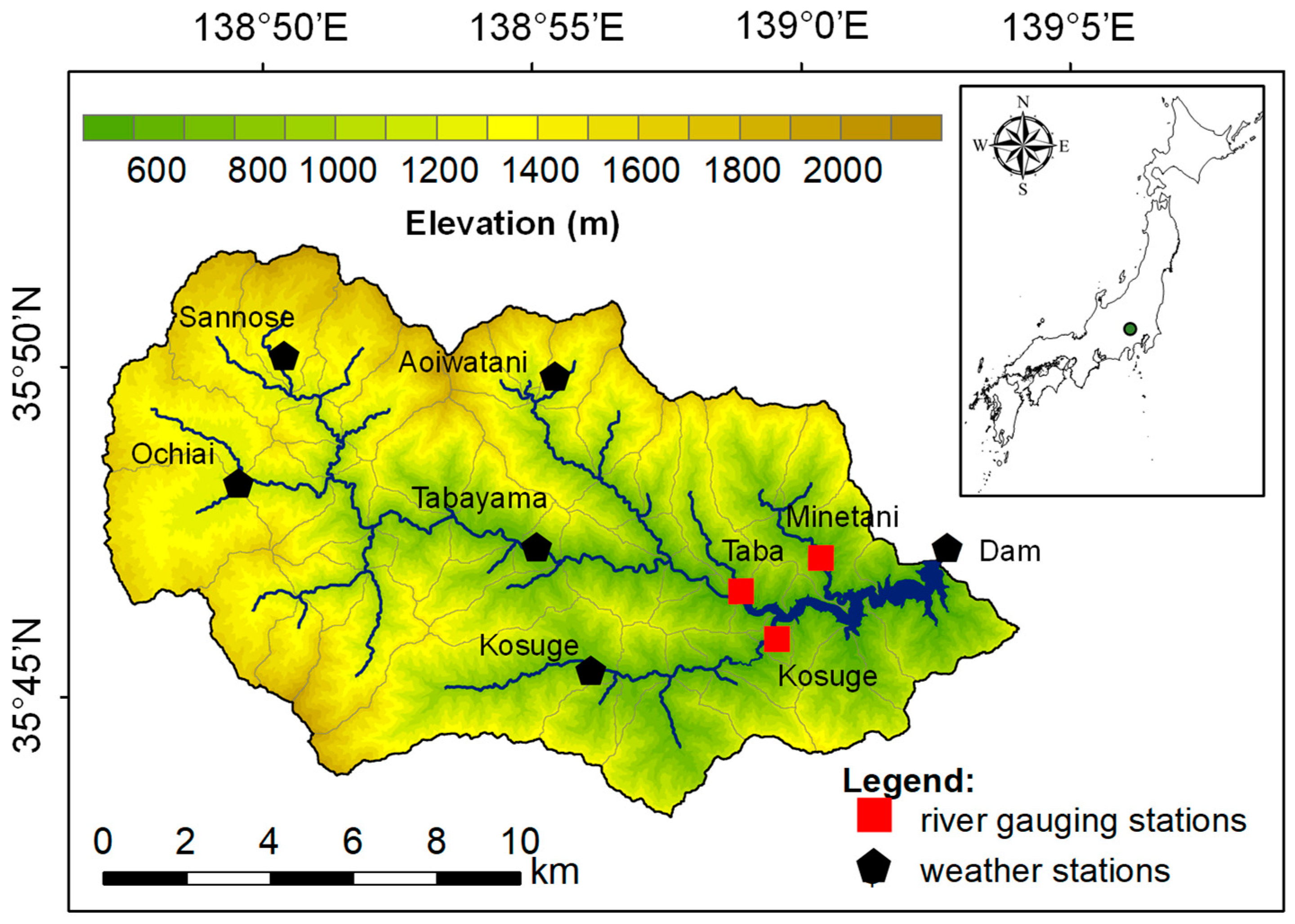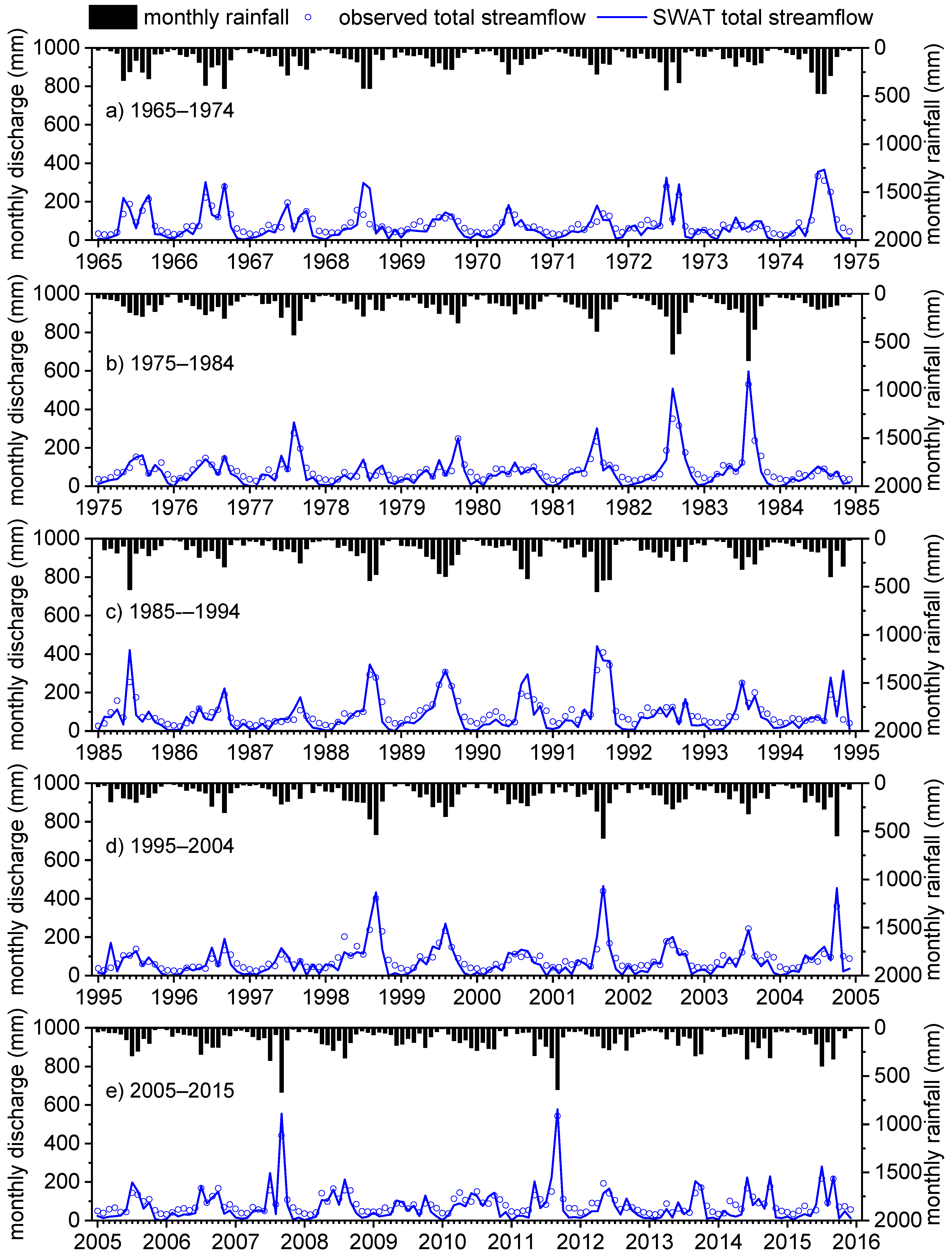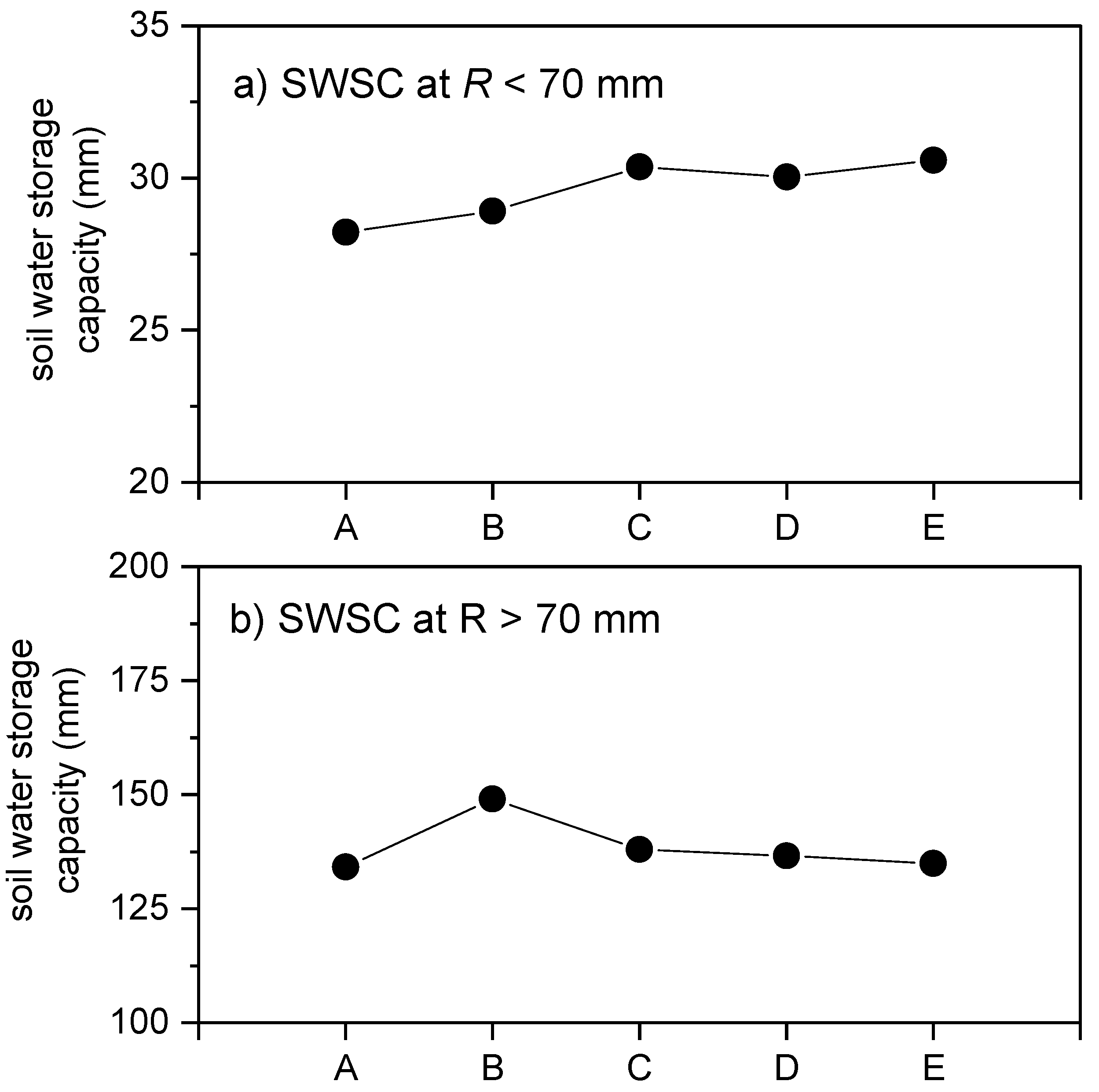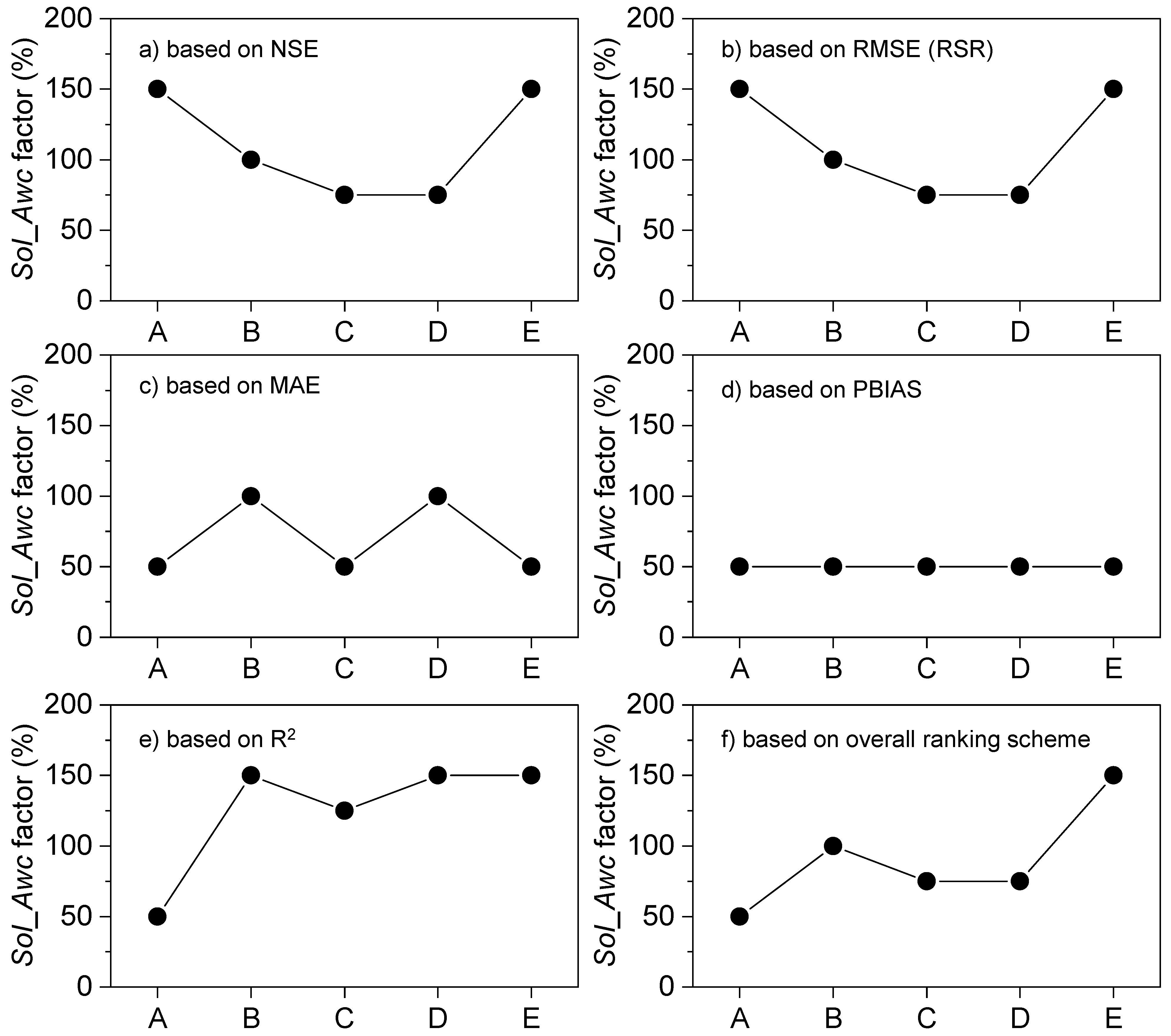Decadal Changes in Soil Water Storage Characteristics Linked to Forest Management in a Steep Watershed
Abstract
:1. Introduction
2. Materials and Methods
2.1. Study Area Description
2.2. Long-Term Analysis of Rainfall and Runoff Data
2.3. Discharge Modeling and Parameter Adjustment in SWAT
3. Results
3.1. Rainfall–Runoff Correlation Plots
3.2. Performance of Initial SWAT Calculation per Decade
4. Discussion
4.1. Trends in Soil Water Storage Capacity Based on Correlation Analysis
4.2. Trends in Runoff Potential and Soil Available Water Capacity Based on Parameter Evaluation in SWAT
5. Conclusions
Author Contributions
Funding
Data Availability Statement
Acknowledgments
Conflicts of Interest
References
- Peters, N.E.; Aulenbach, B.T. Water storage at the Panola Mountain Research Watershed, Georgia, USA. Hydrol. Process. 2011, 25, 3878–3889. [Google Scholar] [CrossRef]
- Chen, J.; Shao, C.; Jiang, S.; Qu, L.; Zhao, F.; Dong, G. Effects of changes in precipitation on energy and water balance in a Eurasian meadow steppe. Ecol. Process. 2019, 8, 17. [Google Scholar] [CrossRef]
- Vaes, G.; Willems, P.; Berlamont, J. Rainfall input requirements for hydrological calculations. Urban Water 2001, 3, 107–112. [Google Scholar] [CrossRef]
- Tuo, Y.; Duan, Z.; Disse, M.; Chiogna, G. Evaluation of precipitation input for SWAT modeling in Alpine catchment: A case study in the Adige river basin (Italy). Sci. Total Environ. 2016, 573, 66–82. [Google Scholar] [CrossRef] [Green Version]
- Paudel, S.; Benjankar, R. Integrated hydrological modeling to analyze the effects of precipitation on surface water and groundwater hydrologic processes in a small watershed. Hydrology 2022, 9, 37. [Google Scholar] [CrossRef]
- Zhang, Y.; Liu, J.; Xu, X.; Tian, Y.; Li, Y.; Gao, Q. The response of soil moisture content to rainfall events in semi-arid area of Inner Mongolia. Procedia Environ. Sci. 2010, 2, 1970–1978. [Google Scholar] [CrossRef] [Green Version]
- Karpouzos, D.K.; Baltas, E.A.; Kavalieratou, S.; Babajimopoulos, C. A hydrological investigation using a lumped water balance model: The Aison River Basin case (Greece). Water Environ. J. 2011, 25, 297–307. [Google Scholar] [CrossRef]
- Saito, L.; Biondi, F.; Devkota, R.; Vittori, J.; Salas, J.D. A Water balance approach for reconstructing streamflow using tree-ring proxy records. J. Hydrol. 2015, 529, 535–547. [Google Scholar] [CrossRef] [Green Version]
- Solander, K.; Saito, L.; Biondi, F. Streamflow simulation using a water-balance model with annually-resolved inputs. J. Hydrol. 2010, 387, 46–53. [Google Scholar] [CrossRef]
- Ries, F.; Schmidt, S.; Sauter, M.; Lange, J. Controls on runoff generation along a steep climatic gradient in the Eastern Mediterranean. J. Hydrol. Reg. Stud. 2017, 9, 18–33. [Google Scholar] [CrossRef]
- Hu, C.; Zhao, D.; Jian, S. Baseflow Estimation in typical catchments in the Yellow River Basin, China. Water Sci. Technol. Water Supply 2021, 21, 648–667. [Google Scholar] [CrossRef]
- Aboelnour, M.; Gitau, M.W.; Engel, B.A. A comparison of streamflow and baseflow responses to land-use change and the variation in climate parameters using SWAT. Water 2020, 12, 191. [Google Scholar] [CrossRef] [Green Version]
- Shao, G.; Zhang, D.; Guan, Y.; Sadat, M.A.; Huang, F. Application of different separation methods to investigate the baseflow characteristics of a semi-arid sandy area, Northwestern China. Water 2020, 12, 434. [Google Scholar] [CrossRef] [Green Version]
- Farrick, K.K.; Branfireun, B.A. Soil Water Storage, Rainfall and runoff relationships in a tropical dry forest catchment. Water Resour. Res. 2014, 50, 9236–9250. [Google Scholar] [CrossRef]
- Shi, P.; Yang, T.; Xu, C.Y.; Yong, B.; Huang, C.S.; Li, Z.; Qin, Y.; Wang, X.; Zhou, X.; Li, S. Rainfall-runoff processes and modelling in regions characterized by deficiency in soil water storage. Water 2019, 11, 1858. [Google Scholar] [CrossRef] [Green Version]
- Ghajarnia, N.; Kalantari, Z.; Orth, R.; Destouni, G. Close co-variation between soil moisture and runoff emerging from multi-catchment data across Europe. Sci. Rep. 2020, 10, 4817. [Google Scholar] [CrossRef] [Green Version]
- Crow, W.T.; Chen, F.; Reichle, R.H.; Xia, Y.; Liu, Q. Exploiting soil moisture, precipitation, and streamflow observations to evaluate soil moisture/runoff coupling in land surface models. Geophys. Res. Lett. 2018, 45, 4869–4878. [Google Scholar] [CrossRef]
- Sazib, N.; Bolten, J.; Mladenova, I. Exploring spatiotemporal relations between soil moisture, precipitation, and streamflow for a large set of watersheds using Google Earth Engine. Water 2020, 12, 1371. [Google Scholar] [CrossRef]
- Liu, W.; Xu, Z.; Wei, X.; Li, Q.; Fan, H.; Duan, H.; Wu, J. Assessing hydrological responses to reforestation and fruit tree planting in a sub-tropical forested watershed using a combined research approach. J. Hydrol. 2020, 590, 125480. [Google Scholar] [CrossRef]
- Farley, K.A.; Jobbágy, E.G.; Jackson, R.B. Effects of afforestation on water yield: A global synthesis with implications for policy. Glob. Chang. Biol. 2005, 11, 1565–1576. [Google Scholar] [CrossRef]
- Wei, X.; Li, Q.; Zhang, M.; Giles-Hansen, K.; Liu, W.; Fan, H.; Wang, Y.; Zhou, G.; Piao, S.; Liu, S. Vegetation cover—Another dominant factor in determining global water resources in forested regions. Glob. Chang. Biol. 2018, 24, 786–795. [Google Scholar] [CrossRef] [PubMed]
- Li, Q.; Wei, X.; Zhang, M.; Liu, W.; Giles-Hansen, K.; Wang, Y. The cumulative effects of forest disturbance and climate variability on streamflow components in a large forest-dominated watershed. J. Hydrol. 2018, 557, 448–459. [Google Scholar] [CrossRef]
- Matsushita, B.; Xu, M.; Onda, Y.; Otsuki, Y.; Toyota, M. Detecting forest degradation in Kochi, Japan: Ground-based measurements versus satellite (Terra/ASTER) remote sensing. Hydrol. Process. 2010, 24, 588–595. [Google Scholar] [CrossRef]
- Higashino, M.; Stefan, H.G. Variability and change of precipitation and flood discharge in a Japanese river basin. J. Hydrol. Reg. Stud. 2019, 21, 68–79. [Google Scholar] [CrossRef]
- Kuehler, E.; Hathaway, J.; Tirpak, A. Quantifying the benefits of urban forest systems as a component of the green infrastructure stormwater treatment network. Ecohydrology 2017, 10, e1813. [Google Scholar] [CrossRef]
- Yang, L.; Wei, W.; Chen, L.; Mo, B. Response of deep soil moisture to land use and afforestation in the semi-arid Loess Plateau, China. J. Hydrol. 2012, 475, 111–122. [Google Scholar] [CrossRef]
- Kabeja, C.; Li, R.; Guo, J.; Rwatangabo, D.E.R.; Manyifika, M.; Gao, Z.; Wang, Y.; Zhang, Y. The impact of reforestation induced land cover change (1990–2017) on flood peak discharge using HEC-HMS hydrological model and satellite observations: A study in two mountain basins, China. Water 2020, 12, 1347. [Google Scholar] [CrossRef]
- Liu, J.; Li, S.; Ouyang, Z.; Tam, C.; Chen, X. Ecological and socioeconomic effects of China’s policies for ecosystem services. Proc. Natl. Acad. Sci. USA 2008, 105, 9477–9482. [Google Scholar] [CrossRef] [Green Version]
- Mizuno, T.; Kojima, N.; Asano, S. The risk reduction effect of sediment production rate by understory coverage rate in granite area mountain forest. Sci. Rep. 2021, 11, 14415. [Google Scholar] [CrossRef]
- Moos, C.; Bebi, P.; Schwarz, M.; Stoffel, M.; Sudmeier-Rieux, K.; Dorren, L. Ecosystem-based disaster risk reduction in mountains. Earth-Sci. Rev. 2018, 177, 497–513. [Google Scholar] [CrossRef]
- Chen, L.; Yuan, Z.; Shao, H.; Wang, D.; Mu, X. Effects of thinning intensities on soil infiltration and water storage capacity in a Chinese pine-oak mixed forest. Sci. World J. 2014, 2014, 268157. [Google Scholar] [CrossRef] [PubMed] [Green Version]
- Wang, T.; Xu, Q.; Gao, D.; Zhang, B.; Zuo, H.; Jiang, J. Effects of thinning and understory removal on the soil water-holding capacity in Pinus massoniana plantations. Sci. Rep. 2021, 11, 13029. [Google Scholar] [CrossRef] [PubMed]
- Bethlahmy, N. First year effects of timber removal on soil moisture. Int. Assoc. Sci. Hydrol. Bull. 1962, 7, 34–38. [Google Scholar] [CrossRef] [Green Version]
- Ide, J.; Finér, L.; Laurén, A.; Piirainen, S.; Launiainen, S. Effects of clear-cutting on annual and seasonal runoff from a boreal forest catchment in eastern Finland. For. Ecol. Manag. 2013, 304, 482–491. [Google Scholar] [CrossRef]
- Ilek, A.; Kucza, J.; Szostek, M. The effect of stand species composition on water storage capacity of the organic layers of forest soils. Eur. J. For. Res. 2015, 134, 187–197. [Google Scholar] [CrossRef] [Green Version]
- Takatsuki, S. Effects of sika deer on vegetation in Japan: A review. Biol. Conserv. 2009, 142, 1922–1929. [Google Scholar] [CrossRef]
- Nagaike, T.; Ohkubo, E.; Hirose, K. Vegetation recovery in response to the exclusion of grazing by sika deer (Cervus nippon) in seminatural grassland on Mt. Kushigata, Japan. ISRN Biodivers. 2014, 2014, 1–6. [Google Scholar] [CrossRef] [Green Version]
- Suzuki, M. Succession of abandoned coppice woodlands weakens tolerance of ground-layer vegetation to ungulate herbivory: A test involving a field experiment. For. Ecol. Manag. 2013, 289, 318–324. [Google Scholar] [CrossRef]
- Gunay, C.J.; Hashimoto, Y.; Yokoyama, K.; Sakai, H.; Koizumi, A.; Sakai, K.; Kuroki, N. Estimation of erodibility coefficients based on geophysical forest properties in Ogouchi Dam watershed. J. Jpn. Soc. Civ. Eng. Ser. G (Environ. Res.) 2021, 77, I_61–I_68. [Google Scholar] [CrossRef]
- James, S.E.; Pärtel, M.; Wilson, S.D.; Peltzer, D.A. temporal heterogeneity of soil moisture in grassland and forest. J. Ecol. 2003, 91, 234–239. [Google Scholar] [CrossRef]
- Su, X.; Wang, M.; Huang, Z.; Fu, S.; Chen, H.Y.H. Forest understorey vegetation: Colonization and the availability and heterogeneity of resources. Forests 2019, 10, 944. [Google Scholar] [CrossRef] [Green Version]
- Ohnuki, Y.; Nik, A.R.; Noguchi, S.; Sasaki, S. Sediment discharge through buffer zones in a tropical rainforest of Peninsular Malaysia. Jpn. Agric. Res. Q. 2010, 44, 187–196. [Google Scholar] [CrossRef] [Green Version]
- López-Vicente, M.; Kramer, H.; Keesstra, S. Effectiveness of soil erosion barriers to reduce sediment connectivity at small basin scale in a fire-affected forest. J. Environ. Manag. 2021, 278, 111510. [Google Scholar] [CrossRef] [PubMed]
- Gunay, C.J.; Duka, M.; Yokoyama, K.; Sakai, H.; Koizumi, A.; Sakai, K.; Kuroki, N. Half-century analysis of climate trends and soil water storage in a steep forested catchment in Kanto metropolitan area. J. Jpn. Soc. Civ. Eng. Ser. B1 (Hydraul. Eng.) 2021, 77, I_487–I_492. [Google Scholar] [CrossRef] [PubMed]
- Sugawara, M. Automatic calibration of the tank model. Hydrol. Sci. Bull. 1979, 24, 375–388. [Google Scholar] [CrossRef] [Green Version]
- Castillo, V.M.; Gómez-Plaza, A.; Martínez-Mena, M. The role of antecedent soil water content in the runoff response of semiarid catchments: A simulation approach. J. Hydrol. 2003, 284, 114–130. [Google Scholar] [CrossRef]
- Seeger, M.; Errea, M.P.; Beguería, S.; Arnáez, J.; Martí, C.; García-Ruiz, J.M. Catchment soil moisture and rainfall characteristics as determinant factors for discharge/suspended sediment hysteretic loops in a small headwater catchment in the Spanish pyrenees. J. Hydrol. 2004, 288, 299–311. [Google Scholar] [CrossRef] [Green Version]
- Arnold, J.G.; Srinivasan, R.; Muttiah, R.S.; Williams, J.R. Large area hydrologic modeling and assessment Part I: Model development. 1998, 34, 73–89.
- Jiang, R.; Li, Y.; Wang, Q.; Kuramochi, K.; Hayakawa, A.; Woli, K.P.; Hatano, R. Modeling the water balance processes for understanding the components of river discharge in a non-conservative watershed. Trans. ASABE 2011, 54, 2171–2180. [Google Scholar] [CrossRef]
- Zhang, D.; Lin, Q.; Chen, X.; Chai, T. Improved curve number estimation in SWAT by reflecting the effect of rainfall intensity on runoff generation. Water 2019, 11, 163. [Google Scholar] [CrossRef] [Green Version]
- Moriasi, D.N.; Arnold, J.G.; Van Liew, M.W.; Bingner, R.L.; Harmel, R.D.; Veith, T.L. Model evaluation guidelines for systematic quantification of accuracy in watershed simulations. Trans. ASABE 2007, 50, 885–900. [Google Scholar] [CrossRef]
- Eckhardt, K. How to construct recursive digital filters for baseflow separation. Hydrol. Process. 2005, 19, 507–515. [Google Scholar] [CrossRef]
- Bosch, D.D.; Arnold, J.G.; Allen, P.G.; Lim, K.J.; Park, Y.S. Temporal variations in baseflow for the Little River experimental watershed in South Georgia, USA. J. Hydrol. Reg. Stud. 2017, 10, 110–121. [Google Scholar] [CrossRef]
- Goel, M.K. Runoff coefficient. In Encyclopedia of Snow, Ice and Glaciers, Encyc; Singh, V.P., Singh, P., Haritashya, U.K., Eds.; Springer: Berlin/Heidelberg, Germany, 2011. [Google Scholar]
- Luo, Y.; Arnold, J.; Allen, P.; Chen, X. Baseflow simulation using SWAT model in an inland river basin in Tianshan Mountains, Northwest China. Hydrol. Earth Syst. Sci. 2012, 16, 1259–1267. [Google Scholar] [CrossRef] [Green Version]
- Chang, Z.; Ye, X.; Zhang, J. Soil water infiltration of subalpine shrub forest in Qilian Mountains, northwest of China. Agron. J. 2021, 113, 829–839. [Google Scholar] [CrossRef]
- Schwartz, R.C.; Schlegel, A.J.; Bell, J.M.; Baumhardt, R.L.; Evett, S.R. Contrasting tillage effects on stored soil water, infiltration and evapotranspiration fluxes in a dryland rotation at two locations. Soil Tillage Res. 2019, 190, 157–174. [Google Scholar] [CrossRef]
- Picchio, R.; Mederski, P.S.; Tavankar, F. How and How much, Do harvesting activities affect forest soil, regeneration and stands? Curr. For. Rep. 2020, 6, 115–128. [Google Scholar] [CrossRef] [Green Version]
- Cui, Z.; Huang, Z.; Luo, J.; Qiu, K.; López-Vicente, M.; Wu, G.L. Litter cover breaks soil water repellency of biocrusts, enhancing initial soil water infiltration and content in a semi-arid sandy land. Agric. Water Manag. 2021, 255, 107009. [Google Scholar] [CrossRef]
- Zemke, J.J.; Enderling, M.; Klein, A.; Skubski, M. The influence of soil compaction on runoff formation. A case study focusing on skid trails at forested andosol sites. Geosci. 2019, 9, 204. [Google Scholar] [CrossRef] [Green Version]
- Miura, S.; Hirai, K.; Yamada, T. Transport rates of surface materials on steep forested slopes induced by raindrop splash erosion. J. For. Res. 2002, 7, 201–211. [Google Scholar] [CrossRef]
- Yuan, Y.; Nie, W.; Mccutcheon, S.C.; Taguas, E.V. Initial abstraction and curve numbers for semiarid watersheds in Southeastern Arizona. Hydrol. Process. 2014, 28, 774–783. [Google Scholar] [CrossRef]
- Lim, K.J.; Engel, B.A.; Muthukrishnan, S.; Harbor, J. Effects of initial abstraction and urbanization on estimated runoff using CN technology. J. Am. Water Resour. Assoc. 2006, 42, 629–643. [Google Scholar] [CrossRef]
- Woodward, D.E.; Hawkins, R.H.; Jiang, R.; Hjelmfelt, A.T.; Van Mullem, J.A.; Quan, Q.D. Runoff curve number method: Examination of the initial abstraction ratio. World Water Environ. Resour. Congr. 2003, 40685, 691–700. [Google Scholar] [CrossRef] [Green Version]
- Gunay, C.J.; Nakagawa, C.; Yokoyama, K.; Sakai, H.; Koizumi, A.; Iwasaki, H.; Chiba, T. Changes in soil hydrological condition of Ogouchi Dam catchment from SWAT monthly discharge analysis for 57 years. In Proceedings of Japan Water Works Association; Japan Water Works Association: Tokyo, Japan, 2020; Volume 2020, pp. 762–763. [Google Scholar] [CrossRef]
- Gunay, C.J.C.; Nakagawa, C.; Yokoyama, K. Analyzing long-term changes in water discharge and soil condition of Ogouchi Reservoir catchment. In Proceedings of the 22nd Congress of the International Association for Hydro-Environment Engineering and Research-Asia Pacific Division (IAHR-APD 2020), Sapporo, Japan, 14–17 September 2020. [Google Scholar]
- Bergeson, C.B.; Martin, K.L.; Doll, B.; Cutts, B.B. Soil infiltration rates are underestimated by models in an urban watershed in central North Carolina, USA. J. Environ. Manag. 2022, 313, 115004. [Google Scholar] [CrossRef] [PubMed]










| Performance Ratings | RSR * | NSE | PBIAS |
|---|---|---|---|
| Very good | 0.00 ≤ RSR ≤ 0.50 | 0.75 < NSE ≤ 1.00 | PBIAS < ±10 |
| Good | 0.50 < RSR ≤ 0.60 | 0.65 < NSE ≤ 0.75 | ±10 ≤ PBIAS < ±15 |
| Satisfactory | 0.60 < RSR ≤ 0.70 | 0.50 < NSE ≤ 0.65 | ±15 ≤ PBIAS < ±25 |
| Unsatisfactory | RSR > 0.70 | NSE ≤ 0.50 | PBIAS ≥ ±25 |
| Decade (Inclusive Years) | NSE | RMSE (RSR) | MAE | PBIAS | R2 | Rating |
|---|---|---|---|---|---|---|
| A (1965–1974) | 0.5511 | 40.6292 (0.6700) | 30.7408 | +11.2922 | 0.7884 | Good |
| B (1975–1984) | 0.7812 | 32.8114 (0.4678) | 25.1448 | +10.6191 | 0.9074 | Very Good |
| C (1985–1994) | 0.5546 | 48.5011 (0.6674) | 35.2636 | +13.7074 | 0.7765 | Satisfactory |
| D (1995–2004) | 0.7171 | 36.5458 (0.5319) | 28.6352 | +12.6753 | 0.8416 | Good |
| E (2005–2015) | 0.6705 | 37.9704 (0.5741) | 32.7002 | +17.6204 | 0.8762 | Good |
| Sol_Awc Factor | NSE (Score) | RMSE (RSR) (Score) | MAE (Score) | PBIAS (Score) | R2 (Score) | Overall Score |
|---|---|---|---|---|---|---|
| 0.50 | 0.7677 (1) | 33.8019 (0.4819) (1) | 25.8466 (4) | +9.3387 (5) | 0.9072 (1) | 12 |
| 0.75 | 0.7698 (4) | 33.6532 (0.4798) (4) | 26.3091 (3) | +12.7516 (3) | 0.9092 (3) | 17 |
| 1.00 | 0.7812 (5) | 32.8114 (0.4678) (5) | 25.1448 (5) | +10.6191 (4) | 0.9074 (2) | 21 |
| 1.25 | 0.7694 (3) | 33.6818 (0.4802) (3) | 27.1401 (2) | +16.8144 (2) | 0.9121 (4) | 14 |
| 1.50 | 0.7692 (2) | 33.6963 (0.4804) (2) | 27.4067 (1) | +18.1169 (1) | 0.9130 (5) | 11 |
Disclaimer/Publisher’s Note: The statements, opinions and data contained in all publications are solely those of the individual author(s) and contributor(s) and not of MDPI and/or the editor(s). MDPI and/or the editor(s) disclaim responsibility for any injury to people or property resulting from any ideas, methods, instructions or products referred to in the content. |
© 2022 by the authors. Licensee MDPI, Basel, Switzerland. This article is an open access article distributed under the terms and conditions of the Creative Commons Attribution (CC BY) license (https://creativecommons.org/licenses/by/4.0/).
Share and Cite
Gunay, C.J.C.; Yokoyama, K.; Sakai, H.; Koizumi, A.; Sakai, K. Decadal Changes in Soil Water Storage Characteristics Linked to Forest Management in a Steep Watershed. Water 2023, 15, 54. https://doi.org/10.3390/w15010054
Gunay CJC, Yokoyama K, Sakai H, Koizumi A, Sakai K. Decadal Changes in Soil Water Storage Characteristics Linked to Forest Management in a Steep Watershed. Water. 2023; 15(1):54. https://doi.org/10.3390/w15010054
Chicago/Turabian StyleGunay, Charles John Consignado, Katsuhide Yokoyama, Hiroshi Sakai, Akira Koizumi, and Kenji Sakai. 2023. "Decadal Changes in Soil Water Storage Characteristics Linked to Forest Management in a Steep Watershed" Water 15, no. 1: 54. https://doi.org/10.3390/w15010054
APA StyleGunay, C. J. C., Yokoyama, K., Sakai, H., Koizumi, A., & Sakai, K. (2023). Decadal Changes in Soil Water Storage Characteristics Linked to Forest Management in a Steep Watershed. Water, 15(1), 54. https://doi.org/10.3390/w15010054







